Brooding keets and baby Guinea fowl.

How do you brood keets?
The Guinea keets need to be brooded for at least the first 4 weeks of the life using the same brooder and techniques you would for chickens. This can be with either a Guinea hen, a chicken hen or an artificial brooder.
Guinea fowl keets are, like their game bird cousins, very lively and can escape through even the smallest gap. They are also easily panicked and can pile into corners and crush much more readily than chicks.
Below: Mixed colour Guinea keets in the brooder.
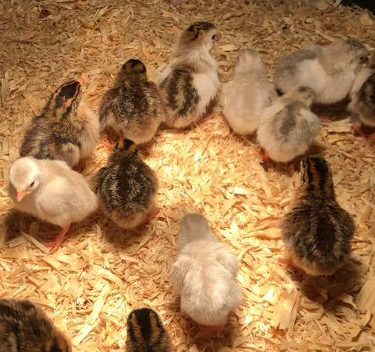
Keets will need a continuous supply of fresh feed and water and they will make a mess and splash the water everywhere.
Guinea chicks or keets require food almost immediately. At most six hours after hatching and should be fed and cared for in the same manner as young turkeys but can be given a little more freedom.
It should be observed that they require more constant feeding with a high protein foodstuff than other poultry. More than 24 hours without food is generally fatal to them.
Baby Guinea fowl keets are very strong on their legs, and in fine weather may be allowed to wander with the hen when very young.
How often do Guinea hens go broody?
Guinea hens are very broody and 50% of them go broody in spring. I have found Guinea hens to be much less predictable than chickens when it comes to going broody. They tend to only become broody in spring when the weather warms up and generally only once.
They are more like wild birds that lay a clutch of eggs and then begin to sit.
They can go broody on just three or four eggs on their own or in large communal nest with 50 eggs in. It's not unusual to have 3 or more hens sharing a nest.
They also have a tendency to choose unsuitable spots that make them vulnerable to predators.
Can you brood keets with a mother hen?
You can hatch, raise and brood keets with a mother hen. This is really the ideal way to do it. Hens will happily raise Guinea fowl keets as their own and the added advantage is the young Guineas will learn to roost from their mother and are more likely to live in the coop rather than the trees.
Below: A clutch of young Guineas following their chicken mother around.
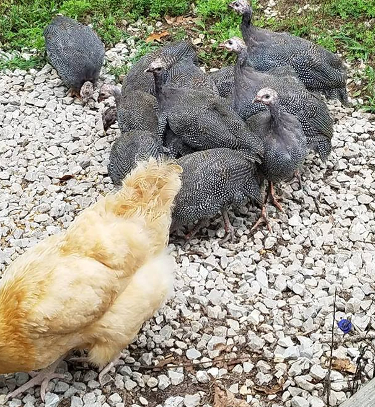
It also seems to make them easier to train and tame and makes them less flighty.
Keets hatched under a chicken will see her as mum and follow her around quite happily, perhaps for even longer than chicks might.
They will learn from her and develop to be a little more chicken like in their manner.
Why are Guinea fowl such bad mothers?
It is important to bear in mind that Guinea Fowl evolved to live in Africa which is considerably warmer and dryer than Europe or parts of North America. It is for this reason so many of their young die and Guineas are perceived to be bad mothers.
They are not really bad mothers, they just don't necessarily behave like other types of poultry and they are not fully domesticated like chickens or ducks.
I have plenty of Guinea hens that have successfully raised a batch of youngsters on their own.
Below: Guinea hens are formidable when protecting their young.
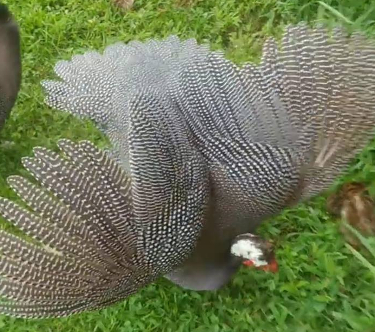
Guinea hens can be formidably and will tip their wings up and charge at you if you go too near her young family. They can be quite frightening.
She just does not realise that her brood will get cold and damp in the long wet grass, her brain is still in Africa where it is warmer and dryer.
How to brood Guinea keets artificially:
When rearing Guinea fowl chicks by artificial means don't forget that they are far more flighty than any other types of domesticated poultry.
Below: Here is a batch of well grown Guinea fowl keets in the brooder.
Guinea fowl chicks fly well from a very early age. I have found one perched on a door before.
It's essential that whatever method of brooding you use make sure they are prevented from escaping by fitting a secure netting or wire-covered top.
Keets that are not raised by a hen need the warmth and safety that a brooder provides, from the time they hatch in the incubator until they are fully feathered, which is at least 6 weeks old.
First brooders can be as simple as a cardboard box, with a 40-60 watt light bulb in a metal hooded shade to a store bought brooder for chicks or any home-made fancier wood wire brooding box.
You should use 2 heat sources in case one fails.
Card boxes or rings are easy to clean, just prepare a new box, move the keets in and toss the old box into the trash or compost heap.
The size of the brooder depends on the number of baby Guinea keets you want to keep in it, their size, and the condition of the surroundings.
Use of a regular light bulb under a hooded shade is usually all that is required when a brooder is kept inside a house. This cardboard box will do fine for the keets who will spend their first week in it at 98F degrees.
The room the brooder is in, whether outdoors or in a house will determine the need for a heat lamp or regular light bulb, combined with the temperature surrounding the brooder and time of the year.
Temperatures in the guinea fowl brooder need to start at 98F or 37C degrees, and drop around 5 degrees weekly until the keets are fully feathered.
How do you keep keets warm?
You need a heat source such as an electric hen, heat pad, incandescent lamp, ceramic heat bulb or burner to keep keets warm in the brooder.
Guinea chicks are better able to regulate their own body temperature and the brooder should be cool with a hot spot at 98F or 37C rather than trying to keep the whole area warm.
Below: You can see the DONUT or GOLDILOCKS EFFECT demonstrated. A little too hot in the centre and too cool on the edge. The keets are sleeping in the comfort zone, huddled to keep warm enough without overheating.
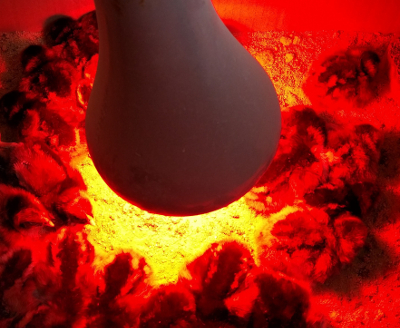
Beware of temperature increases during the hot hours of the day, or drops overnight and adjust the height of the lamp to maintain the minimum required temps directly under the light at floor level.
This is a picture of my larger brooder, great to use when raising a large number of keets. Note the solid sides and removable wood panels that are needed in cooler weather to be able to keep the heat inside and drafts out. The lid is divided into two sections, a wooden frame with wire centres for ventilation, both on hinges.
The inside of the large brooder pictured above has a removable solid wood divider in the centre and is used to keep the keets on one side when young and removed as they grow and need more room.
What is the best bedding for keets?
Keets will eat the pine wood shavings, often from the minute they are put in the brooder. One solution is to cover the floor with kitchen towel or newsprint just as you might with chicks.
The best bedding for guinea fowl keets and my solution is to use plain builders sand or very fine gravel as the floor to the brooder. It holds heat better, stays dryer and the Guinea keets will not eat it as readily and if they do it is something they need in their diet anyway. In their home country of Africa Guinea fowl keets would be raised on sand.
They also wont contaminate the water as much on a sand bed.
If your Guinea keets are panting it is most likely that they are too warm or have not got enough water. I have never had keets suffer brooder pneumonia but it is a possibility. Suspect they are warm first and monitor their progress.
Keeping keets amused:
Keets being brooded should be kept entertained with greenery hung in the space for them to peck at and perches for the to roost on. I sprout wheat, barley or oats and let them have access to greenery from a very early age.
Guineas love to look at themselves and a mirror will keep them and you amused for hours.
Make sure that there are no holes around the base and if there are, block them with a bricks or paving slabs or, better still, cover the base of the run with netting so that the growing keets still have access to the grass and insects, but cannot dig their way out.
When can keets leave the brooder?
Guinea keets can leave the brooder from 6 weeks old if the weather is good, dry and warm. If the nighttime temperatures are below 15C or 59F then they should be kept in at least another two weeks.
A holding area in with the big birds teaches keets where they are to eat, sleep, and drink while providing an area that is safe for introduction to an existing flock without pecking and fighting.
Birds sharing a house will soon learn where each bird belongs, both physically and in the pecking order so that when they are introduced and squabbling and scrapping will be minimal.
Roosting begins early when a spot is provided. The edge of a cardboard box works too, but is rather flimsy. Time to move them on to the nursery pen.
Below: Guinea keets ready for the adult coop in a dog cage to acclimatise.
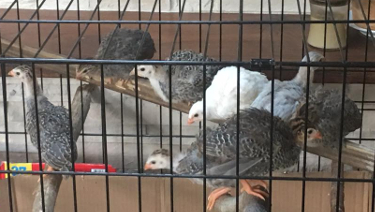
Keets can move from the brooder to the nursery area or holding pen inside the adult guinea house by the time they are 6 weeks old.
Sooner if weather condition permit. You will usually know when it is time to move them on as they will fill their current accommodation and be increasing difficult to look after without additional space.
Keets that outgrow the brooder can be moved to a holding area or nursery pen inside the building where they are to roost as adults.
Provide heat as needed until the keets are fully feathered and outdoor day/night temps match those required in the brooder.
When can keets go outside?
Guinea fowl keets can go outside from 6 weeks of age if the weather is dry and warm otherwise you must wait till they are 8 weeks old.
Guinea keets must be in covered runs for their first trips outside otherwise they will fly away as they panic easily. For more on raising teenage Guinea fowl.
